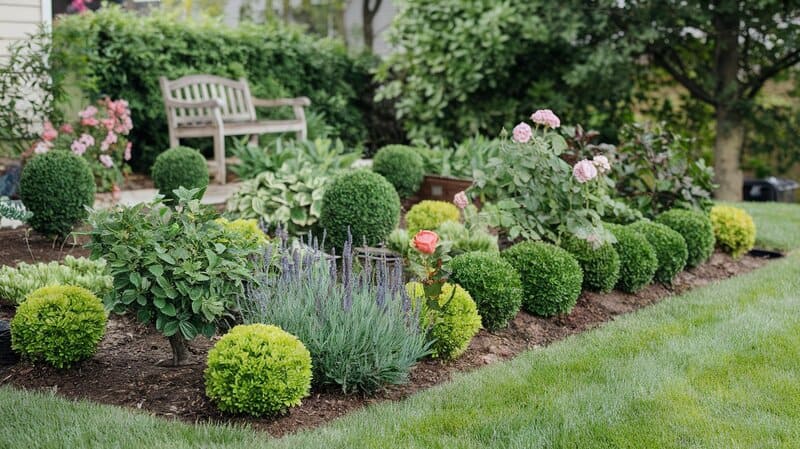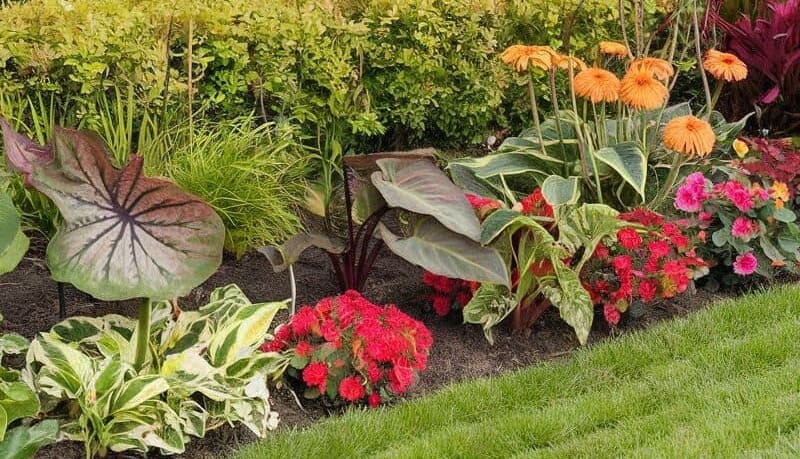
the house garden offer a peaceful and beautiful outdoor space where you can relax, entertain, in this small nature.
In this article, some practical tips on how to design, plant, and maintain a Cheerful house garden. if you’re starting from scratch or enhancing an existing garden, these ideas will help you Add something beautiful to your life.
Benefits of Having a House Garden

Having plants at home forces us to engage with them on a regular basis, which helps us to remember the advantages of going outside. The following are some benefits of having plants in your home:
· Boost wellbeing:
Growing and planting is a hands-on activity that reduces stress and makes your house look and feel better. Additionally, plants have a lot of positive emotional effects! Studies even reveal that residents with access to or near green areas exhibit lower rates of anxiety and despair. Furthermore, fresh produce—whether from your local farmers market, backyard garden, or grocery store—fuels our bodies and promotes healthy lives, which is crucial in light of the current global health crisis.
· Connect us with nature:
Many individuals are looking for meaningful and connected ways to spend this time apart. Whether it's a backyard raised bed or a balcony flower box, home gardening gives us a concrete means of fostering tangible relationships with the environment, our food, and even our neighbors. Taking care of plants at home, whether they be flowers, herbs, or a fully developed vegetable plot, offers our team and others a wonderful chance to build relationships with the environment and one another.
Acquire a new skill:
Growing fresh veggies in your garden or at home is a satisfying, family-friendly, and educational hobby that can be enjoyed by both adults and children. Growing food at home is another method to learn about sustainability.
Choosing the Right Location for Your House Garden

There are a lot of factors to consider when choosing where to plant your garden. Regardless of whether this is your first garden or not, you should pay attention to where it is.
- Sunlight & Sun Exposure: Pick a spot that gets six hours or more of direct sunlight every day. Plants thrive in areas that receive 8–10 hours of direct sunshine every day. Increased sun exposure is beneficial.
- Watering and Water Sources: To make watering your garden or planting pots quick and easy, place them close to a clean water supply. It is generally not recommended to use reclaimed water from rain barrels or similar sources to water plants because of the potential presence of diseases from bird droppings and other pollutants. Water your garden in the morning to ensure that the leaves dry fast. Wet foliage can promote plant diseases that might damage your plants from bacteria and fungi.
- Garden Soil Quality: Plants love soils that drain well and don't pool after prolonged downpours. Additionally, pick locations where there are no possible pollutants in the soil, such as those next to sidewalks that could have had ice-melting chemicals applied to them or regions where runoff from the road may drain.
- Close to the House: Having a garden close to your house can motivate you to spend more time tending to it. If you can view the garden, more weeds will be picked, more plants will be gathered, and more plants will receive regular irrigation.
- Exclusion of wildlife and pets: Plants are best shielded from deer, rabbits, and other animals by fences. The size of the animals determines the fence's dimensions. A three-foot chicken wire fence can keep smaller animals like rabbits out. Fencing that is at least 6 to 8 feet high isrequired for deer.
Tips for Soil Preparation

Soil is practically lifeless without the organic matter and soil organisms that keep it alive. Some refer to the decomposing earth as dirt. It appears worn out, fractured, and gray.
It could contain enough minerals to sustain a few weak plants, but it lacks the live layer of black dirt that makes your garden colorful. Thankfully, there are methods for preparing excellent soil and revitalizing decomposing dirt:
1. Addorganicmatter :
Over time, your plants willdeplete the organic matter in your soil. By adding compost or aged manure, you may feed the bugs and replenish the nutrients in the soil. One time a year, ideally in the autumn or early spring before planting, we advise adding one to three inches.
2. Mulch the Soil:
Mulching the soil on top helps to retain moisture, shield microorganisms from sunlight, enrich the soil with nutrients, and cut down on weeding time. Leafy mulches like leaves, straw, or grass clippings are preferred by vegetables. Bark mulch or wood chips are suitable for perennials, shrubs, or flowers (approximately 2-3 inches).
3. Lessen Soil Compaction:
Your soil's microscopic organisms naturally produce a porous structure that allows both air and water to reach your plants' roots. You compress the gaps in your soil when you walk on your soil, you compress the gaps, especially if it's damp. Therefore, stay on the routes, avoid working in the wet, and minimize any needless soil disturbance if you want to develop healthy soil.
Selecting the right plants
Once you will put in each bed, once you have given it some thought and considered any unique characteristics. When selecting plants, keep the following in mind:
1. The plant'sneeds for light and shade
The simplest thing you can do to promote plant growth is this. For sunny sites, select plants that thrive in full sun; for shady locations, select plants that thrive in shadow.
2. The plant's water requirements
It's an excellent plant for a dry region or a "beyond the end of the hose" plant if it claims drought tolerance or low water consumption. If the plant prefers wet soil, place it in your damp location. If the plant does well around a pond, it usually requires a damp spot. The plant may withstand being submerged in water if it states, "Great for ponds."
3. The size of the globe
Is it spreading, trailing, mounded, or upright? Is it low and broad, tall and narrow, or even tall and wide? Maintenance is greatly simplified by selecting a plant that will thrive in the location it is planted.
4. Check the hardiness zone to ensure that the perennial shrub or tree you are selectingisappropriate for yourregion.
It is still possible to attempt plants with questionable hardiness; simply move them to a spot that stays warmer than others, be ready for the possibility that they won't survive a very harsh winter, or treat them like annuals.
5. Examine the plant'srequirements for upkeep.
While picking high-maintenance plants is OK, you should also think about how much time you want to spend in your garden and make your plant selections appropriately. High-maintenance plants should be placed in areas that you will frequently visit; this will remind you to perform routine upkeep. Many low-maintenance plants are available if you're short on time.

Learn more about choosing houseplants in the Houseplant Community here.
Watering and Irrigation Techniques
Your plants require a lot of water in the heat to keep them from drooping their heads. However, how frequently and in what amount should they be watered? And is watering from below or above preferable? You'll discover some clever and practical information on watering your plants if you keep reading.
Maintain uniform moisture.
Even moisture is essential for most plants. On the other hand, a little dryness before watering encourages the plants' roots to flourish.
Water deeply but seldom.
One or two weekly watering sessions are generally enough to maintain a flower bed; it is preferable to water seldom but thoroughly rather than often.
Use water in the early morning or late evening.
Less water evaporates from water applied to cooled soil in the evening or at night than from heated soil during the day. And before the heat of the next day, the plants may adequately replenish their water supplies.
To prevent illnesses, keep leaves dry.
Wet leaves develop diseases. If left damp overnight, leaf mold illnesses might develop. When leaves are exposed to the sun, the water droplets cause a faint burning sensation on the leaves.
Make sure the roots are receiving water.
Watering needs to be requirement-suited, which means it needs to go to the roots deeply enough. When there is too little irrigation and the soil is covered in mulch, for example, too little water is frequently applied, either barely reaching the top few centimeters of the soil or not at all.
Provide higher amounts of water in segments.
It takes time for water to permeate the ground. It is preferable to water often in sections rather than letting valuable bedwater run off unused.
Use water to aim, but spread
Watering at a single root point only causes one-sided root development, which reduces the soil's ability to absorb nutrients. Water the entire irrigation area and the region surrounding the plant as a result.
Water-saving irrigation techniques
Use as little water as possible and as much as is necessary. An automated watering system with a moisture sensor makes this easier to maintain on the lawn, in the bed, and on the balcony.
Steer clears of flooding.
When roots are unable to breathe air from the soil due to waterlogging, their cells die from a lack of oxygen.
Make use of rich, clay-rich soil.
Because clay minerals in plant soil have higher expansion qualities, they may keep soil in water more evenly and effectively. Make sure there is proper water drainage during the summer and winter to avoid waterlogging.
Sources
- https://www.tuteworld.com/home-garden/home-garden-introduction
- https://www.bayer.com/en/agriculture/benefits-of-home-gardening
- https://bricksandmilestones.com/blog/backyard-gardening-grow-your-own-food-improve-your-health
- https://sebsnjaesnews.rutgers.edu/2020/04/choosing-the-right-location-for-your-vegetable-garden
- https://www.readygardengo.com/blog/what-to-consider-when-choosing-a-location-for-your-garden
- https://platthillnursery.com/best-tips-to-prepare-garden-soil
- https://www.provenwinners.com/learn/right-plant-right-place
- https://www.gardena.com/int/c/discover/gardening/magazine/10-golden-rules-for-watering
"This content is useful - share it on social media!"


yes, thank you